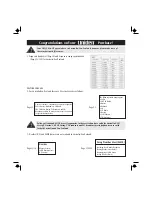
Recommended approach for mobile hazardous area protection:
b
Place the supplied test object in the path of the vehicle and check whether the
vehicle comes to a stop in time.
b
If a number of protective fields are used (in different monitoring cases for exam‐
ple), check whether the vehicle comes to a stop in time in all of the protective
fields.
b
If necessary, change the position of the test object so that a thorough check is
carried out for each monitoring case to determine whether the protective field is
active over the whole of the required width.
b
Check the height of the scan plane. The scan plane must be at a height of at
least 200 mm so that people lying down can be reliably detected. For this purpose,
position the supplied test object at a number of points at the edges of the area
largest protective field. The safe multibeam scanner must detect the test object
at each position and indicate the detection. How it is indicated depends on the
configuration.
Recommended procedure for access protection:
b
Move the supplied test object along the edges of the area to be protected. The
safe multibeam scanner must detect the test object at each position and indicate
the detection. How it is indicated depends on the configuration. The protective
field must be dimensioned such that reaching around or going around it is impos‐
sible.
b
If a number of protective fields are used (in different monitoring cases for exam‐
ple), check the edges of all protective fields.
If the thorough check reveals a fault, the machine should be shut down immediately. In
this case, the mounting and electrical installation of the safe multibeam scanner must
be checked by appropriately qualified safety personnel.
Visual check of the machine and the protective device
Recommended approach:
b
Check whether the machine or the protective device has been modified or manipu‐
lated so that the effectiveness of the protective device may be impaired.
b
In particular, check the following points:
°
Has the machine been retrofitted?
°
Have machine parts been removed?
°
Have modifications been made to the surroundings of the machine?
°
Are there any defective cables or flying leads?
°
Have the protective device or its parts been dismantled?
°
Is the protective device damaged?
°
Is the protective device severely contaminated?
°
Is the front screen contaminated, scratched or destroyed?
°
Has the protective device’s alignment been changed?
°
Are there any objects (e.g. cables, reflective surfaces) in the protective field?
If one of the points applies, the machine should be shut down immediately. In this
case, the machine and the protective device must be checked by appropriately qualified
safety personnel.
4
PROJECT PLANNING
58
O P E R A T I N G I N S T R U C T I O N S | scanGrid2 CANopen
8025990/2021-03-03 | SICK
Subject to change without notice
















































